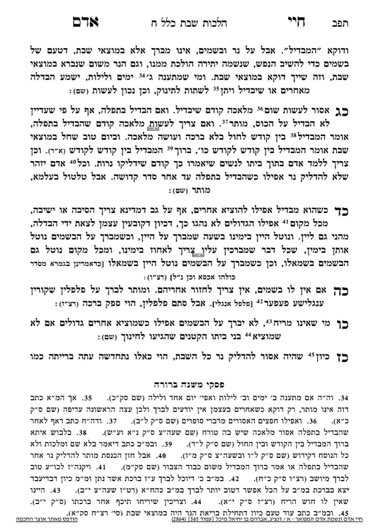We are continuing in siman 25, where the Chayei Adam is discussing besamim for havdalah. We learned that one does not need to wait to recite havdalah until finding besamim. Additionally, we learned about using a specific type of item for besamim. The term used in the Chayei Adam for this item is english pepper, and it is not entirely clear as to what he is referring. “Pepper” is used to refer to two types of species which are not related to each other at all. Bell peppers are used for salads and the like; peppercorns are ground up and made into black pepper or white pepper and used as a spice. The Chayei Adam is discussing making a bracha on this english pepper, which grows on a tree. He is definitely not referring to bell peppers, and is likely referring to peppercorns, but it is still not entirely clear. Either way, the Chayei Adam writes that one may use these peppers for besamim on Motzei Shabbos.
The next question we need to discuss is which bracha is made on the various types of besamim. We know there are multiple brachos which can be recited on besamim. The catch-all bracha is borei minei besamim, which is somewhat akin to shehakol. Bedieved, one is yotzei with the bracha of borei minei besamim on any smell.
Borei isvei besamim is made on plants which grow from the ground but regrow each year, similar to ha’adama.
Borei atzei besamim is made on smells from trees which last from year to year.
Hanosein reiach tov bapeiros is recited on fruits which are fragrant. One example is an esrog.
The difference between atzei besamim and hanosein reiach tov bapeiros is that atzei besamim applies to anything which grows on the tree and not just the fruit. Thus, if a person takes leaves from a fruit-producing tree, the bracha on the leaves will be atzei besamim while the bracha on the fruit will be hanosein reiach tov bapeiros. Additionally, parts of the tree which are considered “fruits” of the tree but are not eaten by people would also receive the bracha of atzei besamim rather than hanosein reiach tov bapeiros.
Something which is not eaten by itself but is used as a spice to flavor other foods would seem to be somewhere in the middle. On the one hand, it is not fruit in the sense that it is eaten like a fruit (so it should be atzei besamim), but on the other hand, it is edible and used in food (so it should be hanosein reiach tov bapeiros). The Mishnah Berurah seems to follow the Shulchan Aruch, who follows the Rosh, that the bracha is hanosein reiach tov bapeiros. However, the Mishnah Berurah brings that some hold the bracha is atzei besamim. It is a machlokes whether one is yotzei their bracha on a fruit with atzei besamim, which creates a dilemma in our case. We will clarify this question further in the next shiur, be’ezras Hashem.
Summary
Borei minei besamim is a catch-all bracha and similar to shehakol
Borei isvei besamim is made on plants which grow from the ground but regrow each year, similar to ha’adama.
Borei atzei besamim is made on smells from trees which last from year to year, and applies to any part of the tree which has a good smell (besides the fruit). It is also recited on fruits of a tree which are not eaten by people.
Hanosein reiach tov bapeiros is specifically for fragrant fruits.



